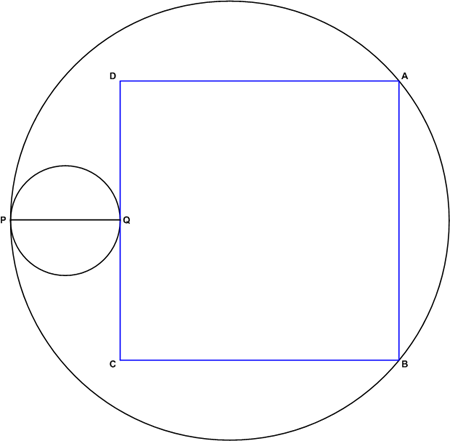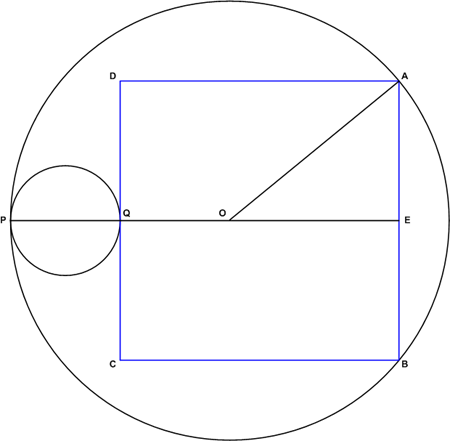Difference between revisions of "1994 AIME Problems/Problem 2"
I like pie (talk | contribs) |
RoFlLoLcOpT (talk | contribs) (→Solution) |
||
| Line 11: | Line 11: | ||
Apply the [[Pythagorean Theorem]]: | Apply the [[Pythagorean Theorem]]: | ||
| − | :<math>(AB - 10)^2 + (\frac 12 AB)^2 = 20^2</math> | + | :<math>(AB - 10)^2 + \left(\frac 12 AB\right)^2 = 20^2</math> |
:<math>AB^2 - 20 AB + 100 + \frac 14 AB^2 - 400 = 0</math> | :<math>AB^2 - 20 AB + 100 + \frac 14 AB^2 - 400 = 0</math> | ||
:<math>AB^2 - 16 AB - 240 = 0</math> | :<math>AB^2 - 16 AB - 240 = 0</math> | ||
Revision as of 10:18, 22 July 2009
Problem
A circle with diameter ![]() of length 10 is internally tangent at
of length 10 is internally tangent at ![]() to a circle of radius 20. Square
to a circle of radius 20. Square ![]() is constructed with
is constructed with ![]() and
and ![]() on the larger circle,
on the larger circle, ![]() tangent at
tangent at ![]() to the smaller circle, and the smaller circle outside
to the smaller circle, and the smaller circle outside ![]() . The length of
. The length of ![]() can be written in the form
can be written in the form ![]() , where
, where ![]() and
and ![]() are integers. Find
are integers. Find ![]() .
.
Solution
Call the center of the larger circle ![]() . Extend the diameter
. Extend the diameter ![]() to the other side of the square (at point
to the other side of the square (at point ![]() ), and draw
), and draw ![]() . We now have a right triangle, with hypotenuse of length
. We now have a right triangle, with hypotenuse of length ![]() . Since
. Since ![]() , we know that
, we know that ![]() . The other leg,
. The other leg, ![]() , is just
, is just ![]() .
.
Apply the Pythagorean Theorem:
The quadratic formula shows that the answer is ![]() . Discard the negative root, so our answer is
. Discard the negative root, so our answer is ![]() .
.
See also
| 1994 AIME (Problems • Answer Key • Resources) | ||
| Preceded by Problem 1 |
Followed by Problem 3 | |
| 1 • 2 • 3 • 4 • 5 • 6 • 7 • 8 • 9 • 10 • 11 • 12 • 13 • 14 • 15 | ||
| All AIME Problems and Solutions | ||











